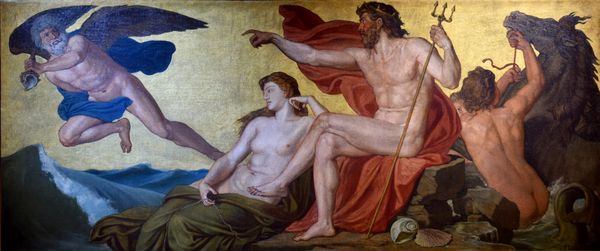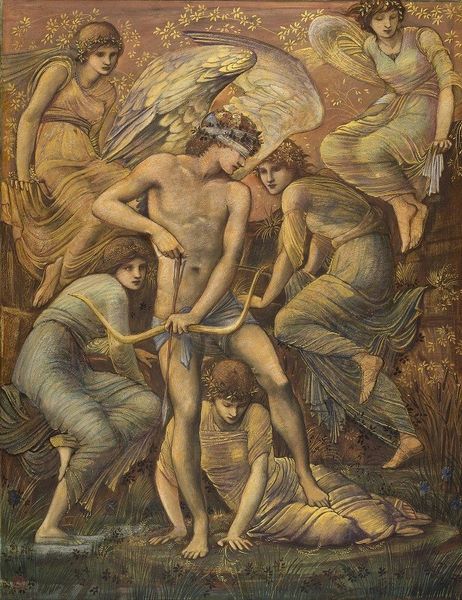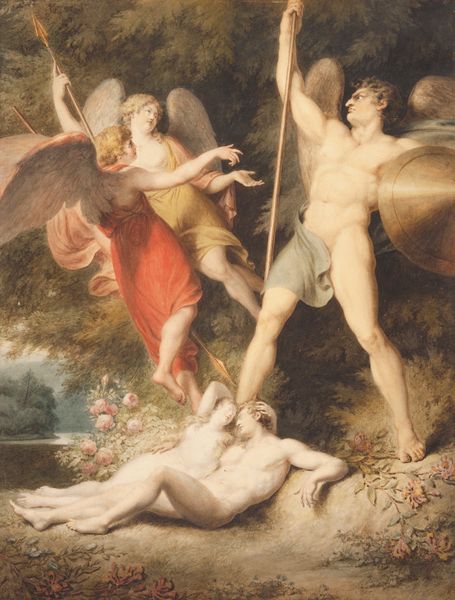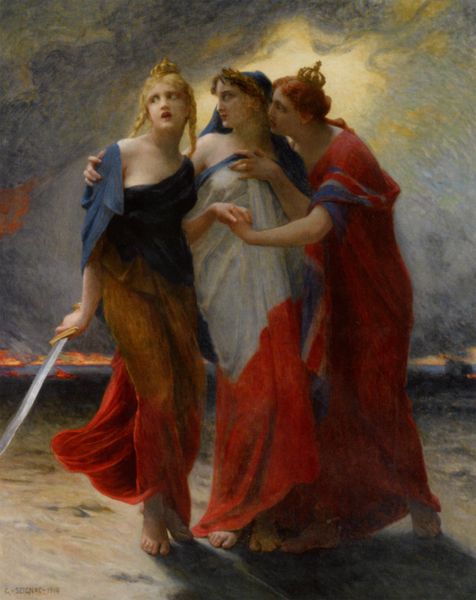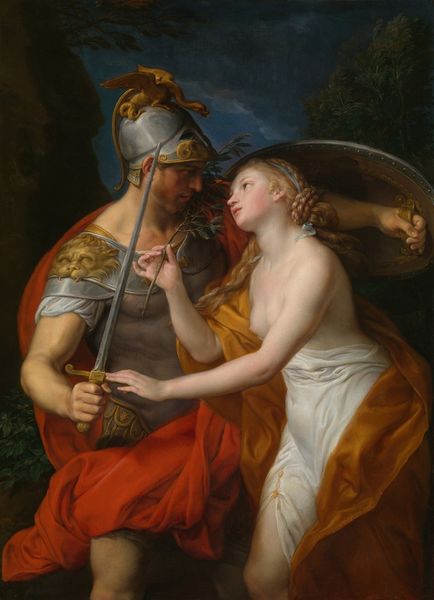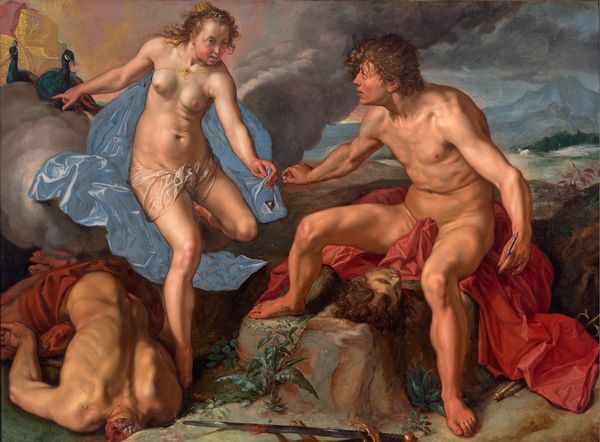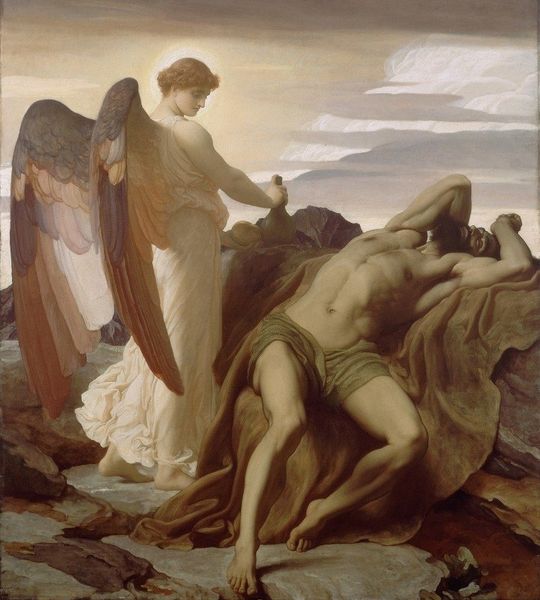
Dimensions: support: 2343 x 1676 mm
Copyright: CC-BY-NC-ND 4.0 DEED, Photo: Tate
Curator: Watts's "Time, Death, and Judgement" is certainly imposing. The figures emerge from a tumultuous background, rendered in a style evocative of classical allegories. Editor: Imposing indeed! My immediate reaction is a somber one. The figures' expressions, especially the draped woman, convey a profound sense of sorrow and resignation. The prevalence of red in the clothing suggests fire or a destructive force. Curator: The draped woman is perhaps the most telling. Notice the flowers she carries. The wilted flowers are symbolic of lost hope or the transience of life. It's difficult to view this figure outside the frame of Victorian mourning culture. Editor: I see what you mean, the flowers underscore the fleeting nature of beauty and youth. The man, presumably Time, brandishes his staff, a symbol of authority, but there is also a vulnerability in his gaze that speaks to his role as a harbinger of change. Curator: Watts often critiqued the rigid social structures of his time. The painting could serve as a reminder that all, regardless of power or privilege, are subject to the same ultimate judgement. The red, also, could symbolize revolution, or even the blood of the disenfranchised. Editor: It is true, the painting carries a heavy message. It urges us to reflect on our own lives and legacies in the face of the inevitable. Curator: Yes, and hopefully, encourages us to act justly and compassionately in the present.
Comments
tate 8 months ago
⋮
http://www.tate.org.uk/art/artworks/watts-time-death-and-judgement-n01693
Join the conversation
Join millions of artists and users on Artera today and experience the ultimate creative platform.
tate 8 months ago
⋮
This work is the third of three well-known large versions made by Watts of the composition Time, Death, and Judgement. It was worked upon constantly between 1889 and 1900 and was given by Watts in 1900 as part of a bequest to the Tate Gallery. The first version of Time, Death, and Judgement (originally titled Time and Death) was begun around 1870 and was bequeathed by Watts to the National Gallery of Canada, Ottawa in 1886. The second large version was given by Watts to St. Paul's Cathedral in 1897, and is currently on loan to the Watts Gallery, Compton. Differences between these three large versions of Time, Death, and Judgement are few and relate merely to surface detail and handling rather than composition. A distinguishing feature of the Tate work is the exposed left leg of Time, which is fully draped in the two earlier versions. Smaller versions of the composition exist, such as that at the Mappin Art Gallery, Sheffield. The monumental, draped figures in Time, Death, and Judgement reveal the enduring influence of Greek sculpture on Watts's art. Watts's friend and biographer, Mrs Russell Barrington (d.1933) described these 'figures of heroic size' as 'sculpturesque in character, not hewn out of smooth, delicate marble, but out of a rough, enduring adamant' (Barrington, p.128). In Time, Death, and Judgement, Time carries the usual attribute of the scythe, but is a youthful male figure rather than than a bearded, old man: 'The eyes of Time are stony,' wrote Mrs Russell Barrington, 'with an unchangeable, never-failing youth; not cruel, only heedless of what may happen as he inevitably presses forward.' (Barrington, p.127). Time has linked hands with Death, a wan, female figure, whose lap 'is full of gathered flowers, buds, blossoms, faded leaves, all together, fulfilling', according to Barrington, '… her mysterious mission of gathering to herself the young, the old, the middle-aged, indiscriminately.' (Barrington, p.127). The figure of Judgement hovers above Time and Death ; she extends the scales of justice and carries a fiery sword, her face obscured to suggest impartiality. Moon and Sun rise and set to right and left. Of Time, Death, and Judgement, Watts wrote to Charles Rickards: 'Allegory is much out of favour now and by most people condemned, forgetting that spiritual and even most intellectual ideas can only be expressed by similes, and that words themselves are but symbols. The design 'Time and Death' is one of several suggestive compositions that I hope to leave behind me in support of my claim to be considered a real artist, and it is only by these that I wish to be known.' (quoted in M.S. Watts, George Frederick Watts: The Annals of An Artist's Life, London 1912, I, p.228). Watts was a dedicated supporter of the work of Canon Barnett (1844-1913), director of the Whitechapel Art Gallery, and his project to improve, through art, the lives of the poor people of London's East End. Watts's Time, Death, and Judgement was the picture by the artist that was most exhibited, discussed and admired by Barnett and Watts gave permission for it to be reproduced as a huge mosaic on the outside of St. Jude's Church, Whitechapel in 1885, where it hung above a public fountain. It was later moved to St. Giles-in-the-Fields Church School, Holborn when St. Jude's was demolished.


